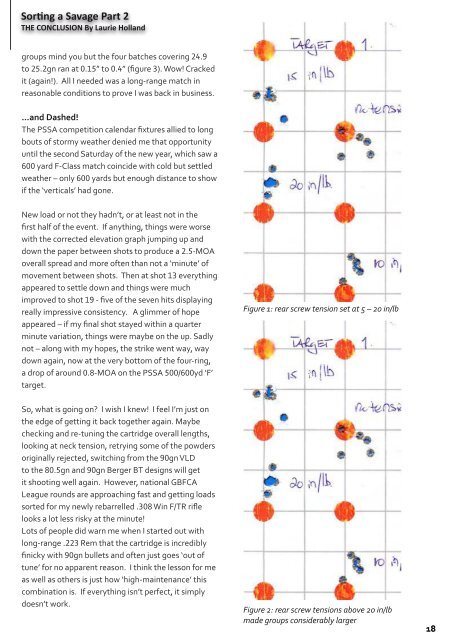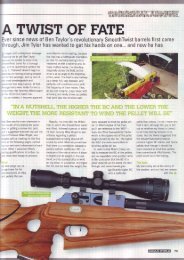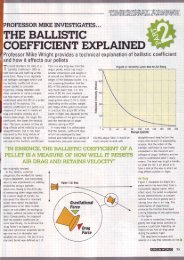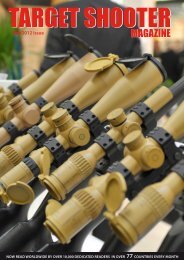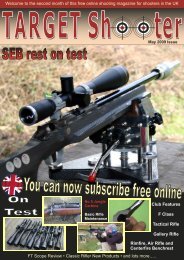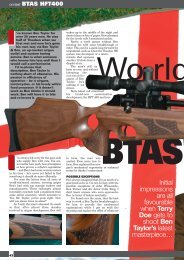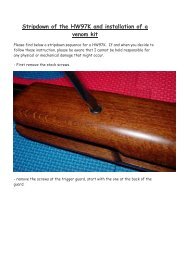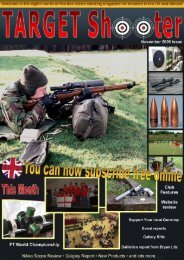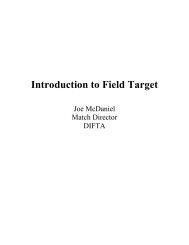February 2012 Issue - Target Shooter Magazine
February 2012 Issue - Target Shooter Magazine
February 2012 Issue - Target Shooter Magazine
You also want an ePaper? Increase the reach of your titles
YUMPU automatically turns print PDFs into web optimized ePapers that Google loves.
Sorting a Savage Part 2<br />
THE CONCLUSION By Laurie Holland<br />
groups mind you but the four batches covering 24.9<br />
to 25.2gn ran at 0.15” to 0.4” (figure 3). Wow! Cracked<br />
it (again!). All I needed was a long-range match in<br />
reasonable conditions to prove I was back in business.<br />
...and Dashed!<br />
The PSSA competition calendar fixtures allied to long<br />
bouts of stormy weather denied me that opportunity<br />
until the second Saturday of the new year, which saw a<br />
600 yard F-Class match coincide with cold but settled<br />
weather – only 600 yards but enough distance to show<br />
if the ‘verticals’ had gone.<br />
New load or not they hadn’t, or at least not in the<br />
first half of the event. If anything, things were worse<br />
with the corrected elevation graph jumping up and<br />
down the paper between shots to produce a 2.5-MOA<br />
overall spread and more often than not a ‘minute’ of<br />
movement between shots. Then at shot 13 everything<br />
appeared to settle down and things were much<br />
improved to shot 19 - five of the seven hits displaying<br />
really impressive consistency. A glimmer of hope<br />
appeared – if my final shot stayed within a quarter<br />
minute variation, things were maybe on the up. Sadly<br />
not – along with my hopes, the strike went way, way<br />
down again, now at the very bottom of the four-ring,<br />
a drop of around 0.8-MOA on the PSSA 500/600yd ‘F’<br />
target.<br />
So, what is going on? I wish I knew! I feel I’m just on<br />
the edge of getting it back together again. Maybe<br />
checking and re-tuning the cartridge overall lengths,<br />
looking at neck tension, retrying some of the powders<br />
originally rejected, switching from the 90gn VLD<br />
to the 80.5gn and 90gn Berger BT designs will get<br />
it shooting well again. However, national GBFCA<br />
League rounds are approaching fast and getting loads<br />
sorted for my newly rebarrelled .308 Win F/TR rifle<br />
looks a lot less risky at the minute!<br />
Lots of people did warn me when I started out with<br />
long-range .223 Rem that the cartridge is incredibly<br />
finicky with 90gn bullets and often just goes ‘out of<br />
tune’ for no apparent reason. I think the lesson for me<br />
as well as others is just how ‘high-maintenance’ this<br />
combination is. If everything isn’t perfect, it simply<br />
doesn’t work.<br />
Figure 1: rear screw tension set at 5 – 20 in/lb<br />
Figure 2: rear screw tensions above 20 in/lb<br />
made groups considerably larger<br />
18 19<br />
I did say before that I’d pass a little more load data on.<br />
Late last year after a new barrel went on, I decided to<br />
give Viht N150 a try. I’d avoided the powder previously<br />
after hearing from Jerry Tierney over in California<br />
that he’d had some worrying pressure spikes with it,<br />
Figure 3: With the tension at just under 15 in/lb, a return to the 90gn VLD / Re15<br />
ammunition combination appeared to have got the rifle shooting well again<br />
getting a huge rise in MV and pressure signs from a<br />
0.2gn charge weight increase. I’ve always liked this<br />
powder with heavy bullets in the cartridge and decided<br />
to give it a try, albeit acting very warily.<br />
Five batches in well-used Lapua match brass, CCI-450<br />
SR Magnum primer and charges of N150 rising from<br />
23.6 to 24.0gn in 0.1gn steps (weighed on Acculab<br />
high-quality electronic scales to accurately allow such<br />
small differentiations) produced 0.2 to 0.7” groups,<br />
only one exceeding the half-inch. The top load<br />
produced a modest MV of 2,641 fps with a small ES of<br />
9 fps, so there is scope for working it up a bit higher.<br />
Before shooters scoff at such ‘low performance’, run<br />
the 90gn Berger BTLR’s external ballistics on a decent<br />
G7 based program. The 800 yard wind-drift for a 2,640<br />
fps load is 6.7-MOA in the classic 10 mph 90-degree<br />
crosswind which is better than that of the NRA’s RWS<br />
.308W / 155gn SMK ammunition, assuming that the<br />
latter produces a full 3,000 fps MV from a ‘tight-bore’<br />
30 inch barrel.<br />
Retained velocities and wind-drift values for this load<br />
fall between those of the ‘old’ and ‘new’ 155gn Sierra<br />
‘Palma’ MKs at a full 3,000 fps MV in fact. I wouldn’t<br />
Sorting a Savage Part 2<br />
THE CONCLUSION<br />
By Laurie Holland<br />
tout this as a 1000 yard load but it shows a great deal<br />
of promise for the shorter-range club shooter, has no<br />
recoil to speak of and will probably give 4,000-5,000<br />
rounds barrel accuracy<br />
life. The 80.5gn Berger<br />
BT at 2800-2900 fps is<br />
gaining a good reputation<br />
too and I’ll try this bullet<br />
later on in the year in<br />
my F/TR rifle as well as<br />
another Savage .223 we’re<br />
working on – a rebarrelled<br />
‘sporter’ designated as ‘an<br />
affordable clubman’s F/TR<br />
rifle’.<br />
Figure 4: Graphed<br />
elevations of the 20 shots in the 600yd Diggle F Class<br />
competition corrected to a common elevation setting<br />
on the riflescope. Despite the use of the Re15 load,<br />
the problem has not been solved! 0 = perfect elevation<br />
with a strike on the V-Bull centreline; low shots have<br />
minus values; high shots have plus values. Shots 13-<br />
19 suggest a solution may be close


